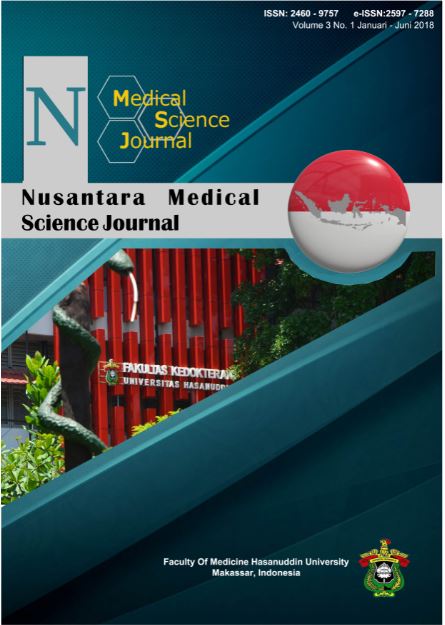THE CORRELATION BETWEEN EPICARDIAL FAT THICKNESS BASED ON MULTI SLICE COMPUTED-TOMOGRAPHY SCAN THORAX WITH WAIST CIRCUMFERENCE AND BODY MASS INDEX ON DYSLIPIDEMIA NON-DIABETES MELLITUS SUBJECT
DOI:
https://doi.org/10.20956/nmsj.v3i1.5774Keywords:
Epicardial fat, MSCT scan Thorax, waist circumference, BMIAbstract
Introduction : Epicardial fat is visceral fat that plays a role in cardiovascular disease. Dyslipidemia non-diabetes mellitus can be found in both obese and non-obese patients. Measurement of waist circumference and BMI can assess central and peripheral obesity. The study aims to finding out the correlation between epicardial fat thickness based on MSCT scan Thorax with waist circumference and BMI on dyslipidemia non-diabetes mellitus subject. Method: There were 57 research samples of 28 to 70 years old who had dysfunction lipid profile. The most samples were found in the age group of 45-64 years with epicardial fat ranges from 2.80 to 10.80 mm and mean of 6.37 mm. Data were analysed by Mann-Whitney and Spearman correlation test. Result: There was a significant correlation between waist circumference and epicardial fat (r = 0.286, p = 0,031). There was no difference in mean of epicardial fat thickness by sex. There was no correlation between sex, and BMI with epicardial fat. Conclusion: There is a correlation between waist circumference and epicardial fat that may be affected by several factors in patients with dyslipidemia non-diabetes mellitus.
References
Demircelik MB., et al. Epicardial adipose tissue and pericoronary fat thickness measured with 64-multidetector computed tomography: potential predictors of the severity of coronary artery disease . CLINICS. 2014;69(6):388-92.
Salazar J., et al. Epicardial fat : physiological, pathological, and therapeutic implications. Cardiology research and practice. 2016;4(1):112-5.
Benedek T., et al. The assessment of epicardial adipose tissue in acute coronary syndrome patients. A systematic review. Journal of Cardiovascular Emergencies 2017;3(1):18-29.
Nuttall FQ. 2015. Body mass index, obesity, BMI and health: a critical review. Nutr Today. 2015;50(3).
Kim SJ, et al. Correlation between epicardial fat thickness by echocardiography and others parameters in obese adolescents. Korean Circulation Journal. 2012;3(1):28-9.
Chumakova GA, et al. Clinical importance of epicardial fat thickness defining in obese patients. Int J of Biomedicine. 2012;2(3) 161-8.
Song DK.,et al. 2015. Increased epicardial adipose tissue thickness in type 2 diabetes mellitus and obesity. Diabetes Metab J 2015;39:405-413.
Shetty R et al. Correlation of epicardial fat and anthropometric measurements in Asian-Indians: a community based study. Avicenna Journal of Medicine. 2012;935(1-2):40-6.
Bertaso AG et al. Epicardial fat: definition,measurements and systematic review of main outcomes. Arq Bras Cardiol. Jul; 101(1):e18-e28.
Piordomenico SD, et al. Epicardial adipose tissue and metabolic syndrome in hypertensive patients with normal body weight and waist circumference. Am J of Hypertension. 2011;36(46):701-4.









